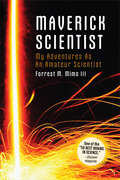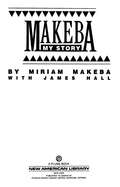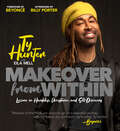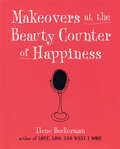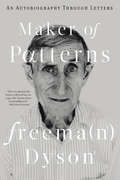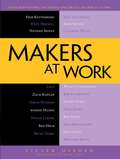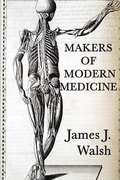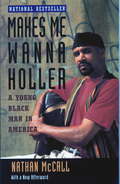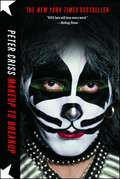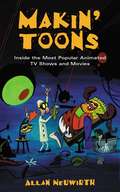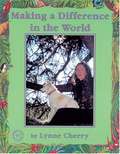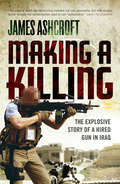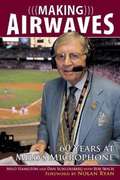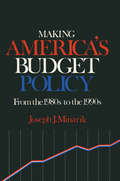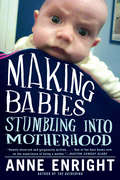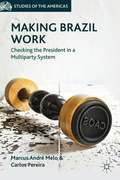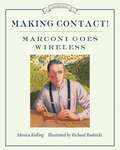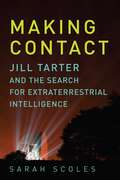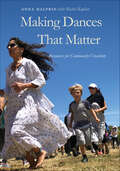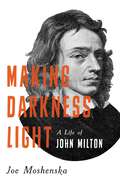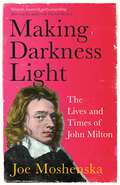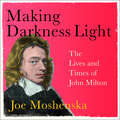- Table View
- List View
Make: My Adventures as an Amateur Scientist
by Forrest M. MimsMaverick Scientist is the memoir of Forrest Mims, who forged a distinguished scientific career despite having no academic training in science. Named one of the "50 Best Brains in Science" by Discover magazine, Forrest shares what sparked his childhood curiosity and relates a lifetime of improbable, dramatic, and occasionally outright dangerous experiences in the world of science.At thirteen he invented a new method of rocket control. At seventeen he designed and built an analog computer that could translate Russian into English and that the Smithsonian collected as an example of an early hobby computer. While majoring in government at Texas A&M University, Forrest created a hand-held, radar-like device to help guide the blind. And during his military service, he had to be given special clearance to do top secret laser research at the Air Force Weapons Lab. Why? Because while he lacked the required engineering degree, they wanted his outside-the-box thinking on the project.He went on to co-found MITS, Inc., producer of the first commercially successful personal computer, wrote a series of electronics books for Radio Shack that sold more than seven million copies, and designed the music synthesizer circuit that became known as the infamous Atari Punk Console. All this came before he started consulting for NASA's Goddard Space Flight Center, and NOAA's famous Mauna Loa Observatory, and earning the prestigious Rolex Award.This intimate portrait of a self-made scientist shares a revelatory look inside the scientific community, and tells the story of a lifelong learner who stood by his convictions even when pressured by the establishment to get in line with conventional wisdom. With dozens of personal photos and illustrations, Maverick Scientist serves as proof that to be a scientist, you simply need to do science.
Makeba: My Story
by James A. HallThe renowned South African singer and political activist recounts her life--a life that encompasses the splendor of international acclaim, bitter personal tragedy, and political intrigue and violence
Makeover from Within: Lessons in Hardship, Acceptance, and Self-Discovery
by Ty HunterA moving and uniquely inspiring book of self-reflection and motivational musings from Ty Hunter, stylist to the stars.In this nuanced mix of memoir, photographs, motivational musings, and wisdom, legendary celebrity stylist Ty Hunter recounts both the trying times and brightest moments of his life. Faced with physical, mental, and emotional obstacles that range from a gunshot wound to caring for his sick parents to simply existing as a Black, gay man in America, Ty channeled his energy into surmounting the unconquerable, along the way developing a resilient spirit—one that begs to be shared with the world.In overcoming his own hardships and blossoming in his career as a stylist, where he worked with superstars like Beyoncé and Billy Porter, Ty has developed a knack for inspiring self-confidence in others. Perfect for the unstoppable badass in your life, this book tells the story of a vibrant soul who defeated the odds and whose goal is to guide you to a brighter and more positive future.DISTINGUISHED AUTHOR: Ty Hunter was Beyoncé's stylist for 18 years, currently works as Billy Porter's head stylist, and launched a fashion line with A Cloud. Ty's substantial following on Instagram, where he shares motivational life advice, demonstrates high demand for his words of wisdom. SUPERSTAR CONTRIBUTORS: Featuring a foreword by multi-platinum Grammy award–winning singer, songwriter, and actress Beyoncé and afterword by multi-award-winning actor, singer, and author Billy Porter. A GREAT READ AND GIFT: This gorgeous book is perfect for birthdays, holidays, Pride celebrations, or any other day that needs some positive energy. INSPIRING STORY: This book sends a bold and inspiring message to underdogs everywhere that they can overcome the impossible and thrive. Perfect for:Fans of Ty Hunter, Beyoncé, Tina Knowles, Billy Porter, and moreFashion and pop culture enthusiasts
Makeovers at the Beauty Counter of Happiness
by Ilene Beckerman"During my life, I've spent thousands of hours and thousands of dollars on my hair, my makeup, and my clothes, trying to look prettier because I grew up believing that pretty girls had happier lives." "I'd be a lot happier now if I had that time and that money back." Ilene Beckerman has lived long enough to have finally learned that there's more to happiness than finding the right hairdo and maintaining an ideal weight. This is never more clear than when she's invited to her fiftieth elementary-school reunion. "Of course I'd go to the reunion." Beckerman says. But delight soon turns to dismay: "I wondered who'd be there. How would they look? Would I look as good? What would I wear? Could I lose twenty pounds by June?" Her reunion presents the perfect occasion to illustrate the anxieties and doubts, the dreams and hard-earned triumphs, of women—from Queen Victoria to Britney Spears. Beckerman knows what really matters in life (besides good hair), and she imparts her wisdom in letters (unsent) to Madonna, Ava Gardner, Sofia Coppola, Meryl Streep, Gwyneth Paltrow, and others, and to her granddaughter Olivia. Frida Kahlo, Cinderella, Whistler's Mother, and Audrey Hepburn make appearances too. In this wise and wonderful book, she shares a lifetime of experience that reminds us that, ultimately, our mothers (and our grandmothers) were right: real beauty comes from within.
Maker of Patterns: An Autobiography Through Letters
by Freeman DysonBoth recalling his life story and recounting many of the major advances in twentieth-century science, a renowned physicist shares his autobiography through letters. While recognizing that quantum mechanics “demands serious attention,” Albert Einstein in 1926 admonished fellow physicist Max Born that the theory “does not bring us closer to the secrets of the Old One.” Aware that “there are deep mysteries that Nature intends to keep for herself,” Freeman Dyson, the 94-year-old theoretical physicist, has nonetheless chronicled the stories of those who were engaged in solving some of the most challenging quandaries of twentieth-century physics. Written between 1940 and the early 1980s, these letters to relatives form an historic account of modern science and its greatest players, including J. Robert Oppenheimer, Richard Feynman, Stephen Hawking, and Hans Bethe. Whether reflecting on the horrors of World War II, the moral dilemmas of nuclear development, the challenges of the space program, or the considerable demands of raising six children, Dyson offers a firsthand account of one of the greatest periods of scientific discovery of our modern age.
Makers at Work
by Steven OsbornWhat do you get when you combine an electronics hobbyist, hacker, garage mechanic, kitchen table inventor, tinkerer, and entrepreneur? A "maker," of course. Playful and creative, makers are--through expertise and experimentation--creating art, products, and processes that change the way we think and interact with the world. As you''ll see from the 21 interviews in Makers at Work, inquisitive makers are just as apt to pick up a laser cutter or an Arduino as a wrench to fashion something new. For example, you''ll meet Jeri Ellsworth, who might provide a video lecture on magnetic logic one day and a tutorial on welding a roll bar on a stock car the next. You''ll also meet Eben Upton, who put cheap, powerful computing in the hands of everyone with the Raspberry Π Becky Stern, who jazzes up clothing with sensors and LEDs; and bunnie Huang, who knows the ins and outs of the Shenzhen, China, electronics parts markets as well as anyone. As all the interviews in Makers at Work show, makers have something in common: reverence for our technical past coupled with an aversion to convention. If they can''t invent new processes or products, it''s simply not worth doing. Crazy as foxes, makers--working in the spirit of Tesla, Wozniak, Edison, Gates, Musk and many others--can bring sophisticated products to the people or to the market as fast or faster than large corporations. And they are not just enabling new technologies and devices--they are changing the way these devices are funded, manufactured, assembled, and delivered. Makers at Work puts a spotlight on the maker mindset and motivation of those who are reinventing the world one object or idea at a time. You will: Meet the individuals who define what it means to be a maker. Learn about the tools and technologies driving the new industrial revolution. Discover ways to scale your weekend project into a profitable business. See how others have used to crowdfunding to make their visions a reality. Learn how open-source hardware and software is enabling whole new categories of products by removing barriers of entry for inventors. The new masters of the "Makerverse" ask two questions: Can it be done? Is it fun? As these interviews will show, the answer to both questions is, "Let''s find out. " What you''ll learn You will: Learn about 3d printing and how it is changing manufacturing. Discover new software tools for designing things on your own. Learn how to source parts, code, or ideas for your creations. Meet maker pioneers who helped open up a new world, and makers who have used crowdfunding to support their efforts. Uncover recipes for success or failure when bringing physical products to market. Learn ways to scale your weekend project into a profitable business from experienced entrepreneurs. Learn how open-source hardware and software is enabling new classes of products by removing the barrier of entry for inventors. Open your mind to new ideas, methods, things, and possibilities. Who this book is for This book is for anyone with an independent spirit, creative bent, or natural curiosity who believes you can create whatever your mind can conceive and wants to see how others have done just that. Table of Contents Erik Kettenburg, Founder, Digistump David Merrill, Cofounder, Sifteo Nathan Seidle, CEO, SparkFun Electronics Laen, Founder, OSH Park Zach Kaplan, Founder and CEO, Inventables Emile Petrone, Founder, Tindie bunnie Huang, Founder, bunnie studios Natan Linder, Founder, FormLabs Ben Heck, Host, The Ben Heck Show Becky Stern, Director of Wearable Electronics, Adafruit Industries Eric Stackpole, Cofounder, OpenROV Eben Upton, Founder, Raspberry Pi Foundation Catarina Mota, Founder, OpenMaterials. org Ward Cunningham, Inventor, Wiki Jeri Ellsworth, Founder, Technical Illusions Sylvia Todd, Maker, Sylvia''s Super Awesome Maker Show! Dave Jones, Host, EEVBlog Bre Pettis, CEO, MakerBot Eric Migicovsky, CEO, Pebble Technology Ian Lesnet, Slashdot Troll, Dangerous Prototypes Massimo Banzi, Cofounder, Arduino
Makers of Modern Asia
by Ramachandra GuhaHardly more than a decade old, the twenty-first century has already been dubbed the Asian Century in recognition of China and Indiaâe(tm)s increasing importance in world affairs. Yet discussions of Asia seem fixated on economic indicatorsâe"gross national product, per capita income, share of global trade. Makers of Modern Asia reorients our understanding of contemporary Asia by highlighting the political leaders, not billionaire businessmen, who helped launch the Asian Century. The nationalists who crafted modern Asia were as much thinkers as activists, men and women who theorized and organized anticolonial movements, strategized and directed military campaigns, and designed and implemented political systems. The eleven thinker-politicians whose portraits are presented here were a mix of communists, capitalists, liberals, authoritarians, and proto-theocratsâe"a group as diverse as the countries they represent. From China, the worldâe(tm)s most populous country, come four: Mao Zedong, leader of the Communist Revolution; Zhou Enlai, his close confidant; Deng Xiaoping, purged by Mao but rehabilitated to play a critical role in Chinese politics in later years; and Chiang Kai-shek, whose Kuomintang party formed the basis of modern Taiwan. From India, the worldâe(tm)s largest democracy, come three: Mohandas Gandhi, Jawaharlal Nehru, and Indira Gandhi, all of whom played crucial roles in guiding India toward independence and prosperity. Other exemplary nationalists include Vietnamâe(tm)s Ho Chi Minh, Indonesiaâe(tm)s Sukarno, Singaporeâe(tm)s Lee Kuan Yew, and Pakistanâe(tm)s Zulfiqar Ali Bhutto. With contributions from leading scholars, Makers of Modern Asia illuminates the intellectual and ideological foundations of Asiaâe(tm)s spectacular rise to global prominence.
Makers of Modern Medicine
by James J. WalshMiiller entered this school in 1810 and Gorrcs did not resign his professorship until 1814, when owing to the publication of a political work he was obliged to flee from the country. It is not known how much influence Gorres exercised over young Miiller, but some at least of his precious love for the natural sciences, which even in his student days led to the making of natural collections of various kinds, seems to have been imbibed under the influence of the philosopher physiologist. The touching of the orbits of the two men, who were destined, more than any of their fellow-citizens of Coblentz, to influence Germany's future, must always remain an interesting consideration in the lives of both. Johann's parents were, as might have been expected, down in the old Catholic Rhineland in the capital of the spiritual principality of Treves, faithful members of the Roman Catholic Church. Very early in life, Johann conceived the wish to become a priest. His mother, rejoiced at her son's idea, was ready to make every possible sacrifice to secure his education. It was with the intention of education for the priesthood, then, that Johann entered the Sekunden Schule, an old college of the Jesuits, in which Jesuit tradition and methods of education still survived, and in which some of the old Jesuit pupils seem still to have held positions even during Mtiller's time as a student (1810 to 1817). It would appear probable that Ix-causc of the traditions of Jesuit teachings that held over at the school in Coblentz, and perhaps, too, because of the presence of some of the old masters and teachers trained by them, Miiller knew the ancient languages so well. He made his own translations of Plato and Aristotle, and consulted the latter.
Makes Me Wanna Holler: A Young Black Man in America
by Nathan MccallExamining the complexities of the problems of black youths from an insider's perspective, an African-American journalist recalls his own troubled childhood, his rehabilitation while in prison, and his successful Washington Post career.
Makeup to Breakup: My Life In and Out of Kiss
by Peter CrissLEGENDARY founding KISS drummer Peter “Catman” Criss has lived an incredible life in music, from the streets of Brooklyn to the social clubs of New York City to the ultimate heights of rock ’n’ roll success and excess. KISS formed in 1973 and broke new ground with their elaborate makeup, live theatrics, and powerful sound. The band emerged as one of the most iconic hard rock acts in music history. Peter Criss, the Catman, was the heartbeat of the group. From an elevated perch on his pyrotechnic drum riser, he had a unique vantage point on the greatest rock show of all time, with the KISS Army looking back at him night after night. Peter Criscuola had come a long way from the homemade drum set he pounded on nonstop as a kid growing up in Brooklyn in the fifties. He endured lean years, street violence, and the rollercoaster music scene of the sixties, but he always knew he’d make it. Makeup to Breakup is Peter Criss’s eye-opening journey from the pledge to his ma that he’d one day play Madison Square Garden to doing just that. He conquered the rock world—composing and singing his band’s all-time biggest hit, “Beth” (1976)—but he also faced the perils of stardom and his own mortality, including drug abuse, treatment in 1982, near-suicides, two broken marriages, and a hard-won battle with breast cancer. Criss opens up with a level of honesty and emotion previously unseen in any musician’s memoir. Makeup to Breakup is the definitive and heartfelt account of one of rock’s most iconic figures, and the importance of faith and family. Rock ’n’ roll has been chronicled many times, but never quite like this.
Makhanlal Chaturvedi
by Shrikant JoshiMakhanlal Chaturvedi has written in all forms of literature. He has made the art of life an immortalized one. He has given new dimension to the expression and a sense of dedication to the literature. Srikant Joshi brings brings out the colours of life of Chaturvedi.
Makhdoom Muhiuddin
by Nishat ZaidiWorks on Ghazals and poems by Mumbai based poet Makhdoom Mohiuddin.
Makin' Toons: Inside the Most Popular Animated TV Shows and Movies
by Allan NeuwirthFrom the first drawing board sketch to wriggling TV character, Makin' Toons illustrates the thrills and challenges of making animated cartoon movies as told by the industry's most successful creators. Cartoon lovers everywhere will be treated to 47 personal interviews with animation artists and industry leaders ranging from Shrek director Andrew Adamson to Rugrats producer Gabor Csupo. These and dozens of other fascinating firsthand accounts chronicle the behind-the-scene antics and commercial dynamics behind such blockbusters as The Simpsons, South Park, Beauty and the Beast, and Dragon Tales, to name just a few. Author Allan Neuwirth-an accomplished animation artist and writer himself-spices the book with insightful comments, hilarious anecdotes, and a true "toon artist's" sense of humor. He also includes 75 never-before-published concept drawings, character designs, storyboards, and much more.Allworth Press, an imprint of Skyhorse Publishing, publishes a broad range of books on the visual and performing arts, with emphasis on the business of art. Our titles cover subjects such as graphic design, theater, branding, fine art, photography, interior design, writing, acting, film, how to start careers, business and legal forms, business practices, and more. While we don't aspire to publish a New York Times bestseller or a national bestseller, we are deeply committed to quality books that help creative professionals succeed and thrive. We often publish in areas overlooked by other publishers and welcome the author whose expertise can help our audience of readers.
Making A Difference in the World
by Lynne Cherry John Christopher FineA prominent children's book author and illustrator shares her life, her daily activities, her interest in environmental preservation, and her creative process, showing how all are intertwined.
Making A Killing: The Explosive Story of a Hired Gun in Iraq
by James AshcroftIn September 2003, James 'Ash' Ashcroft, a former British Infantry Captain, arrived in Iraq as a 'gun for hire'. It was the beginning of an 18-month journey into blood and chaos.In this action-packed page-turner, Ashcroft reveals the dangers of his adrenalin-fuelled life as a security contractor in Baghdad, where private soldiers outnumber non-US Coalition forces in a war that is slowly being privatised. From blow-by-blow accounts of days under mortar bombardment to revelations about life operating deep within the Iraqi community, Ashcroft shares the real, unsanitised story of the war in Iraq - and its aftermath - direct from the front line.
Making Airwaves: 60 Years at Milo's Microphone
by Milo Hamilton Dan Schlossberg Bob IbachSportscaster, Milo Hamilton, discusses his 60-year as a sports announcer, concentrating on baseball. He discusses the teams and people with whom he worked.
Making America's Budget Policy from the 1980's to the 1990's
by Joseph J. MinarikThis collection of articles traces the evolution over the 1980s of budget policy and tax reform by an architect of the Bradley tax reform bill. The articles present a chronological analysis of tax changes and the heated controversy over budget policy and the deficit. It concludes with an analysis of what the future holds. The author, currently staff director of the Joint Economic Committee of Congress, has the perspective of a fiscal expert with many years on the Washington scene.
Making Babies: Stumbling into Motherhood
by Anne EnrightA San Francisco Chronicle Lit Pick "Much of the book is astonishingly funny; the rest would break your heart." --Colm Tóibín Anne Enright is one of the most acclaimed novelists of her generation. The Gathering won the 2007 Man Booker Prize, and her follow-up novel, The Forgotten Waltz, garnered universal praise for her luminous language and deep insight into relationships. Now, in Making Babies, Enright offers a new kind of memoir: an unapologetic look at the very personal experience of becoming a mother. With a refreshing no-nonsense attitude, Enright opens up about the birth and first two years of her children's lives. Enright was married for eighteen years before she and her husband Martin, a playwright, decided to have children. Already a confident, successful writer, Enright continued to work in her native Ireland after each of her two babies was born. While each baby slept, those first two years of life, Enright wrote, in dispatches, about the mess, the glory, and the raw shock of motherhood. Here, unfiltered and irreverent, are Enright's keen reactions to the pains of pregnancy, the joys of breast milk, and the all-too-common pressures to be the "perfect" parent. Supremely observant and endlessly quizzical, Enright is never saccharine, always witty, but also deeply loving. Already a bestseller in the UK, Making Babies brings Enright's autobiographical writing to American readers for the first time. Tender and candid, it captures beautifully just what it's like for a working woman to become a mother. The result is a moving chronicle of parenthood from one of the most distinctive and gifted authors writing today.
Making Brazil Work
by Carlos Pereira Marcus André MeloThis book offers the first conceptually rigorous analysis of the political and institutional underpinnings of Brazil's recent rise. Using Brazil as a case study in multiparty presidentialism, the authors argue that Brazil's success stems from the combination of a constitutionally strong president and a robust system of checks and balances.
Making Contact!: Marconi Goes Wireless (Great Idea Series #5)
by Monica KullingThe fifth book in Tundra's Great Idea Series, Making Contact! tells the story of Guglielmo Marconi, who became the father of wireless communication. As a boy, Marconi loved science and invention. Born in 1874 in Bologna, Italy, to a wealthy family, Marconi grew up surrounded by books in his father's library. He was fascinated with radio waves and learned Morse code, the language of the telegraph. A retired telegraph operator taught him how to tap messages on the telegraph machine. At the age of twenty, Marconi realized that no one had invented a wireless telegraph. Determined to find a way to use radio waves to send wireless messages, Marconi found his calling. And, thanks to his persistence, on December 12, 1901, for the first time ever, a wireless signal traveled between two continents. The rest is history. Monica Kulling's playful, informative text, combined with the compelling illustrations of artist Richard Rudnicki, bring an amazing inventor and his times to life.
Making Contact: Jill Tarter And The Search For Extraterrestrial Intelligence
by Sarah ScolesFor anyone who has ever looked up at the night sky and wondered, "Are we alone?" A brilliant examination of the science behind the search for extraterrestrial intelligence and its pioneer, Jill Tarter, the inspiration for the main character in Carl Sagan's Contact. Jill Tarter is a pioneer, an innovator, an adventurer, and a controversial force. At a time when women weren’t encouraged to do much outside the home, Tarter ventured as far out as she could—into the three-Kelvin cold of deep space. And she hasn’t stopped investigating a subject that takes and takes without giving much back. Today, her computer's screensaver is just the text “SO…ARE WE ALONE?” This question keeps her up at night. In some ways, this is the question that keep us all up at night. We have all spent dark hours wondering about our place in it all, pondering our "aloneness," both terrestrial and cosmic. Tarter’s life and her work are not just a quest to understand life in the universe: they are a quest to understand our lives within the universe. No one has told that story, her story, until now. It all began with gazing into the night sky. All those stars were just distant suns—were any of them someone else's sun? Diving into the science, philosophy, and politics of SETI—searching for extraterrestrial intelligence—Sarah Scoles reveals the fascinating figure at the center of the final frontier of scientific investigation. This is the perfect book for anyone who has ever looked up at the night sky and wondered if we are alone in the universe.
Making Dances That Matter: Resources for Community Creativity
by Rachel Kaplan Anna HalprinAnna Halprin, vanguard postmodern dancer turned community artist and healer, has created ground-breaking dances with communities all over the world. Here, she presents her philosophy and experience, as well as step-by-step processes for bringing people together to create dances that foster individual and group well-being. At the heart of this book are accounts of two dances: the Planetary Dance, which continues to be performed throughout the world, and Circle the Earth. The Circle the Earth workshop for people living with AIDS has generated dozens of "scores" for others to adapt. In addition, the book provides a concrete guide to Halprin's celebrated Planetary Dance. Now more than 35 years old, Planetary Dance promotes peace among people and peace with the Earth. Open to everyone, it has been performed in more than 50 countries. In 1995 more than 400 participants joined her in a Planetary Dance in Berlin commemorating the fiftieth anniversary of the signing of the Potsdam Agreements, at the end of World War II. More recently, she took the Planetary Dance to Israel, bringing together Israelis and Palestinians as well as other nationalities. Throughout this book Halprin shows how dance can be a powerful tool for healing, learning and mobilizing change, and she offers insight and advice on facilitating groups. If we are to survive, Halprin argues, we must learn, experientially, how our individual stories weave together and strengthen the fabric of our collective body. Generously illustrated with photographs, charts and scores, this book will be a boon to dance therapists, educators and community artists of all types.
Making Darkness Light: A Life of John Milton
by Joe MoshenskaAn innovative and elegant new biography of John Milton from an acclaimed Oxford professorJohn Milton was once essential reading for visionaries and revolutionaries, from William Blake to Ben Franklin. Now, however, he has become a literary institution—intimidating rather than inspiring.In Making Darkness Light, Oxford professor Joe Moshenska rediscovers a poet whose rich contradictions confound his monumental image. Immersing ourselves in the rhythms and textures of Milton&’s world, we move from the music of his childhood home to his encounter with Galileo in Florence into his idiosyncratic belief system and his strange, electrifying imagination.Making Darkness Light will change the way we think about Milton, the place of his writings in his life, and his life in history. It is also a book about Milton&’s place in our times: about our relationship with the Western canon, about why and how we read, and about what happens when we let someone else&’s ideas inflect our own.
Making Darkness Light: The Lives and Times of John Milton
by Joe MoshenskaFor most of us John Milton has been consigned to the dusty pantheon of English literature, a grim puritan, sightlessly dictating his great work to an amanuensis, removed from the real world in his contemplation of higher things. But dig a little deeper and you find an extraordinary and complicated human being.Revolutionary and apologist for regicide, writer of propaganda for Cromwell's regime, defender of the English people and passionate European, scholar and lover of music and the arts - Milton was all of these things and more.Making Darkness Light shows how these complexities and contradictions played out in Milton's fascination with oppositions - Heaven and Hell, light and dark, self and other - most famously in his epic poem Paradise Lost. It explores the way such brutal contrasts define us and obscure who we really are, as the author grapples with his own sense of identity and complex relationship with Milton. Retracing Milton's footsteps through seventeenth century London, Tuscany and the Marches, he vividly brings Milton's world to life and takes a fresh look at his key works and ideas around the nature of creativity, time and freedom of expression. He also illustrates the profound influence of Milton's work on writers from William Blake to Virginia Woolf, James Joyce to Jorge Luis Borges.This is a book about Milton, that also speaks to why we read and what happens when we choose over time to let another's life and words enter our own. It will change the way you think about Milton forever.
Making Darkness Light: The Lives and Times of John Milton
by Joe MoshenskaFor most of us John Milton has been consigned to the dusty pantheon of English literature, a grim puritan, sightlessly dictating his great work to an amanuensis, removed from the real world in his contemplation of higher things. But dig a little deeper and you find an extraordinary and complicated human being.Revolutionary and apologist for regicide, writer of propaganda for Cromwell's regime, defender of the English people and passionate European, scholar and lover of music and the arts - Milton was all of these things and more.Making Darkness Light shows how these complexities and contradictions played out in Milton's fascination with oppositions - Heaven and Hell, light and dark, self and other - most famously in his epic poem Paradise Lost. It explores the way such brutal contrasts define us and obscure who we really are, as the author grapples with his own sense of identity and complex relationship with Milton. Retracing Milton's footsteps through seventeenth century London, Tuscany and the Marches, he vividly brings Milton's world to life and takes a fresh look at his key works and ideas around the nature of creativity, time and freedom of expression. He also illustrates the profound influence of Milton's work on writers from William Blake to Virginia Woolf, James Joyce to Jorge Luis Borges.This is an audiobook about Milton, that also speaks to why we read and what happens when we choose over time to let another's life and words enter our own. It will change the way you think about Milton forever.(P) 2021 Hodder & Stoughton Limited
